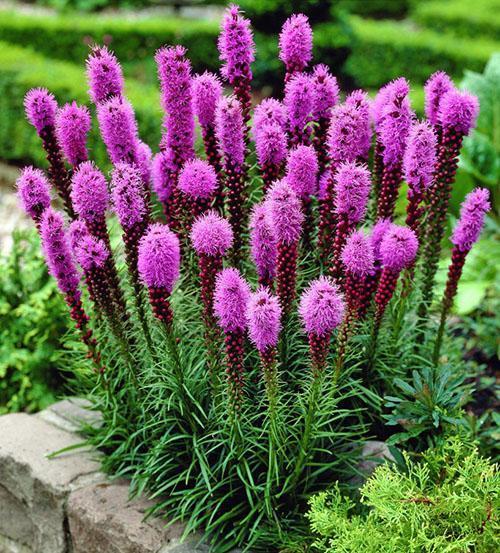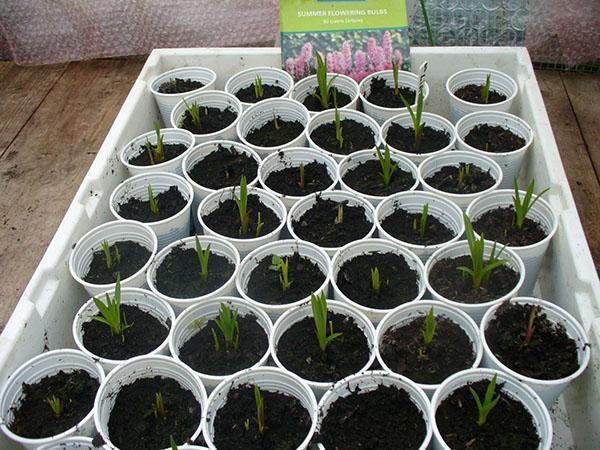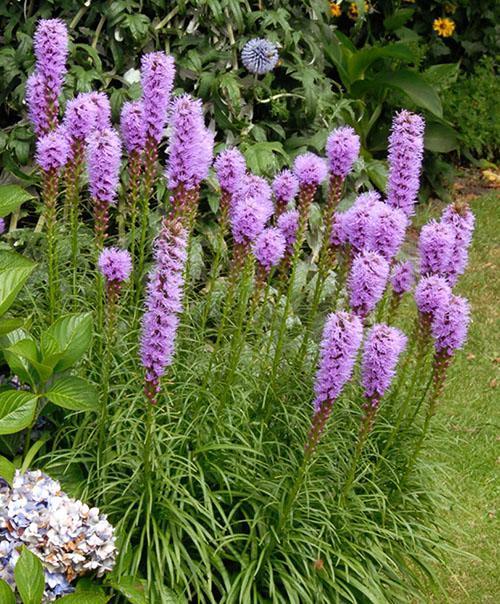All about planting and caring for lyatrix outdoors
 Liatris with fluffy candle inflorescences and a wonderful aroma is a popular decorative perennial for summer cottages. If among the favorite plants of the grower there is liatris, planting and care in the open field are important steps towards its long life and stable flowering.
Liatris with fluffy candle inflorescences and a wonderful aroma is a popular decorative perennial for summer cottages. If among the favorite plants of the grower there is liatris, planting and care in the open field are important steps towards its long life and stable flowering.
Tall liatrix with erect stems, narrow leaves and spike-shaped inflorescences of all shades from snow white to dense purple, one of the most visible plants in garden beds. Natives of the American continent, they are unusually unpretentious, responsive to care, can multiply by seeds and vegetatively, by dividing tuberous rhizomes.
Planting Liatris in open ground with seeds

Seed planting of Liatris in open ground is carried out in the spring, when the ground thaws. In the middle lane, a suitable period lasts from late March to mid-April. Until autumn, young plants will have time to develop enough to start an independent life in a flower bed in spring.
Sowing is carried out in pre-dug nutrient soil to a depth of 1 to 1.5 centimeters. When the furrows are covered, the ridge is watered. Seedlings during the entire warm season need:
- in regular, but moderate watering;
- in weeding the soil next to the seedlings;
- in gentle loosening of the soil surface.
 To save time on weeding, in the spring, after planting liatris in open ground, crops are mulched. If it rains in summer, the plants are not specially watered. Excess moisture can cause rotting of small tubers and rhizomes.
To save time on weeding, in the spring, after planting liatris in open ground, crops are mulched. If it rains in summer, the plants are not specially watered. Excess moisture can cause rotting of small tubers and rhizomes.
In autumn, young liatrixes lose their aerial part. This is a signal for the grower to dig up the tubers and store them until spring.
Planting Liatris in open ground with bulbs
 The decorative perennial grows up and blooms rather late. The first candles above the narrow built-up foliage appear only in the second or third year. If there are already large clumps of this plant on the site or planting material was bought in a store, planting liatris in open ground with bulbs is carried out in the second half of summer. The right time is after flowering, in August or September.
The decorative perennial grows up and blooms rather late. The first candles above the narrow built-up foliage appear only in the second or third year. If there are already large clumps of this plant on the site or planting material was bought in a store, planting liatris in open ground with bulbs is carried out in the second half of summer. The right time is after flowering, in August or September.
Perennials older than three years of age are suitable for reproduction. In August:
- the plants are dug up;
- corms larger than two centimeters are separated;
- the resulting planting material is planted in a suitable place in 8–10 centimeter holes with loose soil mixed with humus.
 The bulbs are planted with a deepening upward, then covered with a layer of soil, which is compacted, watered and mulched. A gap of at least 30–40 cm is left between the holes, so that young flowers have plenty of space and nutrition. After planting, care for the lyatrix in the open field is limited to mulching and weeding.
The bulbs are planted with a deepening upward, then covered with a layer of soil, which is compacted, watered and mulched. A gap of at least 30–40 cm is left between the holes, so that young flowers have plenty of space and nutrition. After planting, care for the lyatrix in the open field is limited to mulching and weeding.
If the fall is dry, the ridge can be watered. For the winter, such plantings are abundantly covered with mulch, spruce branches or other material.
If desired, liatris can be planted not with separate corms, but with parts of an adult, overgrown bush. The main thing is that the delenki have:
- own roots;
- formed tubers;
- healthy growth points.
Planting holes are made to the size of the separated part of the bush, and then, for quick rooting, they are filled with a loose nutrient mixture based on garden soil and humus.
Landing site for Liatris in the open field
 To simplify the care of liatrix after planting in the open field, it is important to choose a place suitable for the culture, while you need to pay attention not only to the decorative qualities of the perennial, but also to its requirements for soil, lighting and other growing conditions.
To simplify the care of liatrix after planting in the open field, it is important to choose a place suitable for the culture, while you need to pay attention not only to the decorative qualities of the perennial, but also to its requirements for soil, lighting and other growing conditions.
 Liatris - large decorative perennial, which has one of the main roles in the flowerbed.
Liatris - large decorative perennial, which has one of the main roles in the flowerbed.
The plant will look great against the background of trees, large coniferous shrubs, next to ornamental deciduous species and in the background of low or ground cover flowering plants.
 The liatris planting site must be sunny. The plant is not afraid of wind, direct midday rays and summer heat. But dense soil, especially oversaturated with moisture, is a risk factor. If you choose a similar site for planting liatris, in the photo, care in the open field will be complicated due to decay of the root system and the development of fungal diseases.
The liatris planting site must be sunny. The plant is not afraid of wind, direct midday rays and summer heat. But dense soil, especially oversaturated with moisture, is a risk factor. If you choose a similar site for planting liatris, in the photo, care in the open field will be complicated due to decay of the root system and the development of fungal diseases.
 If melt or rain moisture accumulates in the summer cottage, groundwater lies close, a drainage layer and a drainage system must be provided under the flower bed.
If melt or rain moisture accumulates in the summer cottage, groundwater lies close, a drainage layer and a drainage system must be provided under the flower bed.
Caring for Liatrix after planting in open ground
 Liatris is surprisingly unassuming and can rightfully bear the title of "flower for lazy summer residents." Flower care is watering, removing weeds and loosening the soil. Young liatresses require the most attention. As soon as the bush grows, the leaf rosette overlaps a significant area of the soil, retaining moisture in it and preventing weed shoots from rising.
Liatris is surprisingly unassuming and can rightfully bear the title of "flower for lazy summer residents." Flower care is watering, removing weeds and loosening the soil. Young liatresses require the most attention. As soon as the bush grows, the leaf rosette overlaps a significant area of the soil, retaining moisture in it and preventing weed shoots from rising.
In dry seasons, liatrix is watered moderately. It is important that the water flow is not strong and does not erode the soil, exposing the superficial root system. If this happens, it is necessary to spud the flower or pour fresh substrate under the base.
Liatris is fed three times during the warm season. In spring, the flower receives nitrogen stimulating the growth of greenery. In the summer, the flower is fertilized twice potash-phosphorus mixtures, pushing flowering and preparing the plant for a dormant period.
 Supports are provided for tall plants. And after wilting, the inflorescences are cut off. If this is not done, the lyatrice will not miss the opportunity to scatter and take over part of the area not due to him. The preparation for winter does not end there. The plant is winter-hardy, but sudden autumn colds, for example, when planting and caring for lyatrix in the open field in the Urals or other regions with a harsh climate, can seriously harm the culture. Therefore, the aerial part, when the leaves turn yellow and dry, is cut off in advance, and the site is thickly mulched with a layer of about 15 cm. The shelter is most important if the winter is snowless.
Supports are provided for tall plants. And after wilting, the inflorescences are cut off. If this is not done, the lyatrice will not miss the opportunity to scatter and take over part of the area not due to him. The preparation for winter does not end there. The plant is winter-hardy, but sudden autumn colds, for example, when planting and caring for lyatrix in the open field in the Urals or other regions with a harsh climate, can seriously harm the culture. Therefore, the aerial part, when the leaves turn yellow and dry, is cut off in advance, and the site is thickly mulched with a layer of about 15 cm. The shelter is most important if the winter is snowless.